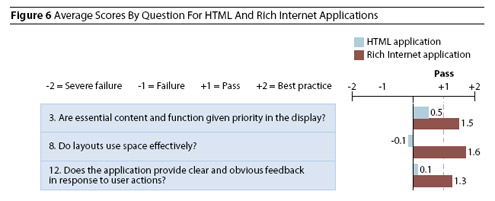Quantifiying experience - Rich Internet Applications are way better than HTML

The paper groups Ajax in with Rich Internet Technology applications and goes on to compare four types of applications: hotel search and reservation engines, mapping tools, PC configurations, and product finders. They also compared and contrasted some "User experience principles" with the HTML experience and the RIA experience. This is a key part of why Rich Internet Applications are so much better than the old guard. For the most part, the list is what you'd expect. Better feedback, and more control, but there are a couple of user experience principles that I liked and wanted to draw out:
| User experience principle | The HTML experience | How RIAs improve the user experience |
| Error handling | Field validation often requires a server call. Error message windows can appear disconnected from areas on a page that require attention. | Form fields are validated in real time as users fill them in — problem areas get highlighted before the form is submitted. |
| Efficient task flow | Processes are broken up into separate pages with server calls in between. | Whole processes contained on a single "page" flow smoothly from end to end. |
Error handling and logical progressions that RIAs provide are both things developers are getting better at taking advantage of and it is translating into big strides in user experience.
The bulk of the paper is dedicated to rundowns of how the various RIAs and HTML applications met usability guidelines set up by Forrester. It's interesting to note that even though half of the 22 sites looked at were RIAs, only 5 passed for usability. All 5 were RIAs, but the number of RIAs that didn't pass shows we have a long way to go.
The Flash-based RIAs faired pretty well, though not as high as I would have thought. The three Flash RIAs that I saw on the list were the Wynn Hotel (Reservations category), Yahoo Maps (Mapping category) and, the Ford car builder (product finders). Only the Yahoo Maps application passed (15 was a passing grade) and the Wynne application clocked in at an 8 while the Ford configuration just missed with 14. It did better than the Blue Nile RIA (a 12) which I thought was a nice example of Ajax.
Probably the most interesting thing for me was the judging criterion in which RIAs did significantly better than their HTML counterparts. I've sliced up the table so you can see the ones with the biggest spread:

I think all three of these areas are ones where designers have a big impact on the RIA and the richness of the applications gives users a much better experience.
The paper is a great analytical look at RIAs and as an Economics major, I really enjoyed seeing the idea of experience quantified and turned into numbers. I think more of these kinds of glimpses are coming this year and as we become better equipped to measure the value of experience, we'll see an even bigger advantage for RIAs.